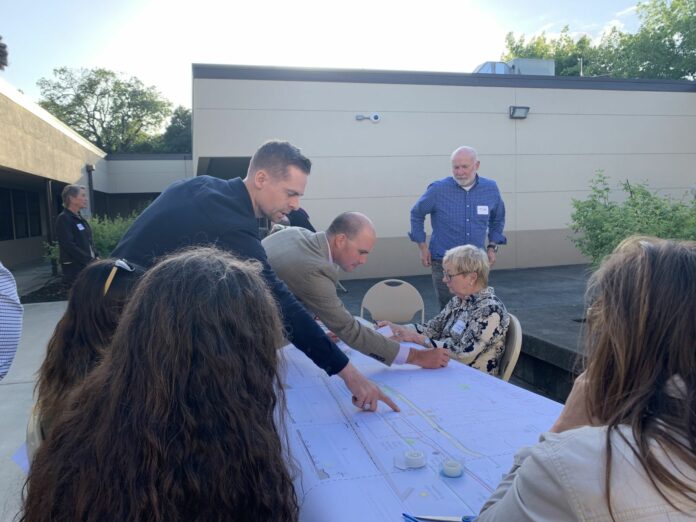Workshop event part of effort to glean community input for a new vision for corridor
Healdsburg community members want a safer Healdsburg Avenue that is more pedestrian-friendly; at least that is what around 30 residents and stakeholders voiced at an improvement study workshop on April 30.
The event, led by the city and urban designers from MIG consulting group, is part of the Healdsburg Avenue Improvement Study, an effort to glean resident input on what updates and improvements are needed for the long stretch of road that winds north through city limits.
A major artery for the city, focus groups on the subject and a community survey found that the overwhelming issue with the avenue is its lack of safety for pedestrians, bikers, motorists and especially children.
Participants also had the chance to design their own segments of road with scaled maps.
Safety may be the biggest concern but there were thoughts that there is an overall lack of connectedness with the surrounding neighborhoods and the Foss Creek Trail.
“There was a lot of talk that it should not just be about Healdsburg Avenue, that it should be about connecting east and west connections to the surrounding, adjoining neighborhoods,” said Mukul Malhotra, a principal urban designer with MIG and the improvement study workshop facilitator.
People also expressed a desire to create an area that clearly represents the community’s identity.
Mukul added that people also want nicer sidewalks that offer shade and more comfort be free of obstacles such as utility poles.
Following a presentation that provided information about the state of the avenue, questions about project funding and costs were brought up.
Clay Thistle, a public works engineer for the city, said they don’t have the costs and dollar estimates yet, but the project will likely take place in phases and be funded in part by grants.
Thistle, along with Assistant City Manager Joe Irvin, added that the project would likely be expensive, especially if they were to put utilities underground.
After questions, attendees broke out into groups to discuss what their overall vision is for the road and how that vision could be implemented.
“This is your chance for you to think about the future and envision something new and be a part of creating something new for your community,” said Carolyn Verheyen, chief operating officer of MIG. “We’ll get you to roll up your sleeves and do some real serious thinking for envisioning the future.”
Mukul emphasized that this stage of the study is critical for getting a sense of what the community wants since they will be the ones living with and using the corridor every day.
“At the end of the day it needs to build on your ideas, what the community wants and what the stakeholders want … We should build on a strong foundation of community ownership,” he said.
One of the groups, which included Kristin Robinson, Katherine Lacy and Tim Unger, went outside to brainstorm their ideas.
Their main ideas for improvement included widening the sidewalks for pedestrians and adding shade trees, creating a safer walking experience with landscape guards — several of the group members said they did not feel safe pushing their kids in strollers — adding a designated bike lane and more crosswalks.
The small number of crosswalks on the road was a big worry. A lot of attendees said when they cross, they have to wait for a safe time and make a made dash across the lanes.
They described it as “very dangerous and an adventure every time.”
Unger suggested adding more services in the Healdsburg Avenue area for the surrounding neighborhoods such as grocery and coffee so density could be spread out.
The group also spoke of adding connection points to reach the Foss Creek Trail. There was also concern about traffic from trucks using Grove Street to turn around, to which another freeway onramp or a roundabout to combat that and help traffic flow was suggested.
Yet Irvin said ambitious projects like a freeway onramp or another roundabout could take years.
Next steps for the project include creating a report of the workshop findings and narrowing down the main points, designing an initial first draft, researching cost estimates, compiling an environmental report and lastly, conducting public hearings and adoption through city commissions/council.
And while the project is still in its early stages, Mukul said of the workshop process, “The political investment is critical to the success of this plan.”
Missed the first workshop? The city will hold a second workshop sometime this summer. Check out the city’s website for updates and dates.
49.3
F
Healdsburg
January 11, 2025








